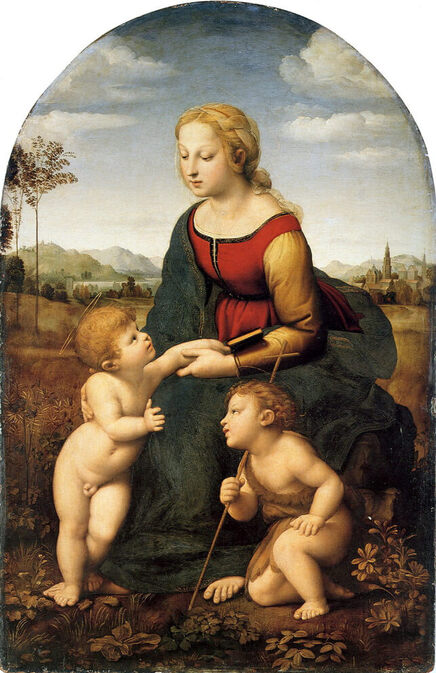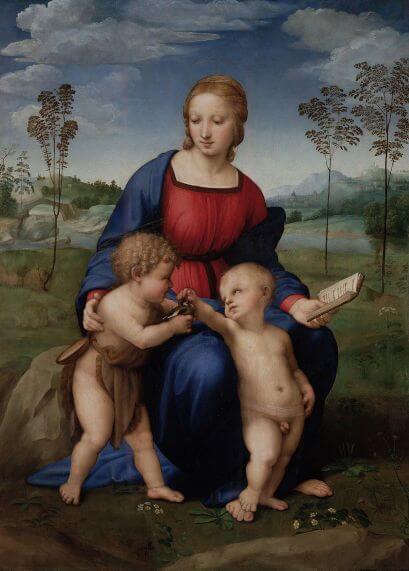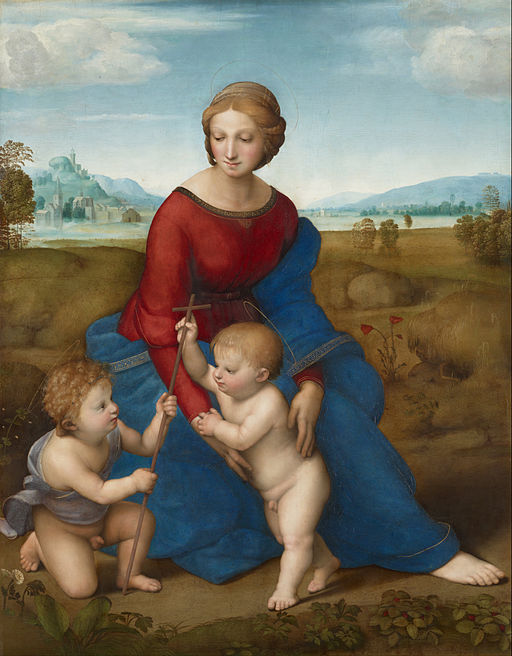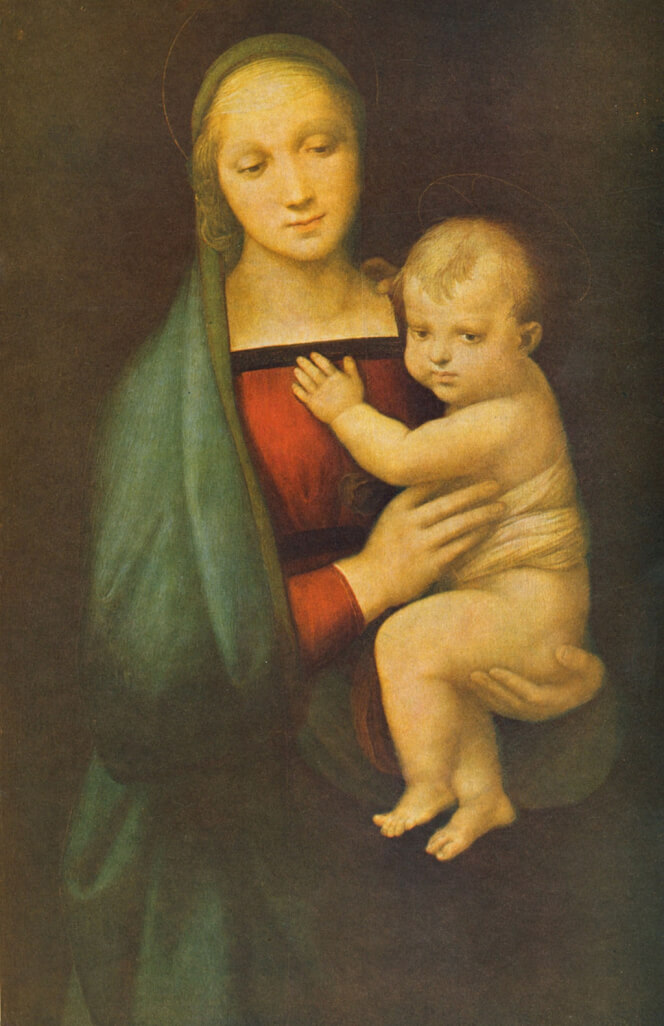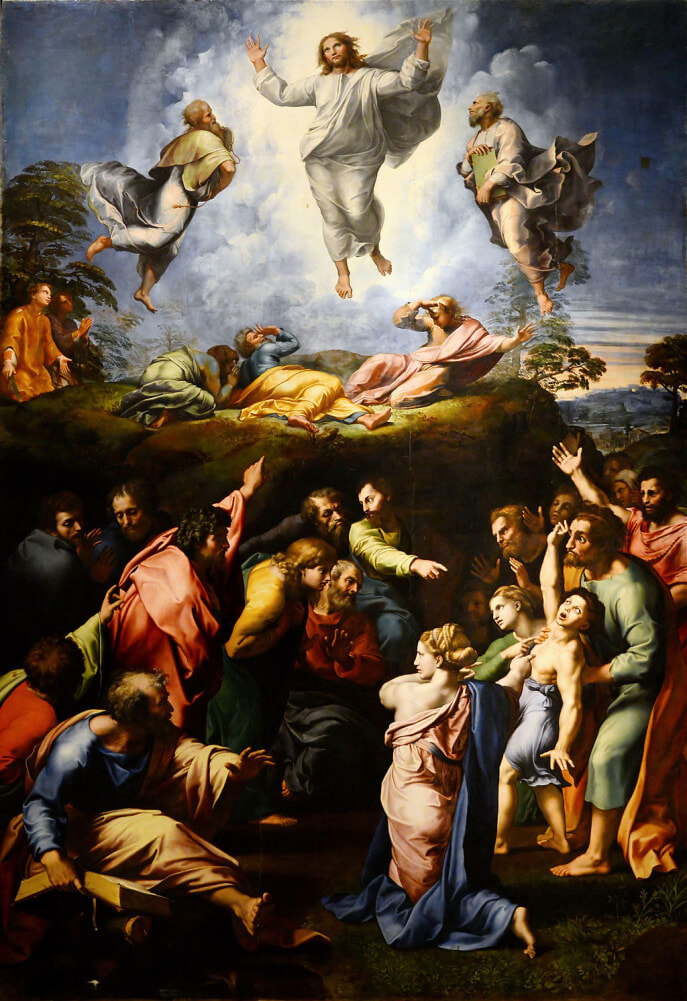|
Where? First floor, room 710 of the Denon wing in the Louvre
When? 1507 or 1508 Commissioned by? Fabrizio Sergardi, a nobleman from Siena, Italy. What do you see? The young Virgin Mary sits on a rock. She wears a red dress with golden sleeves, a dark blue mantle on top of that, and a veil around her head. She holds Baby Jesus with her hands and looks down affectionately at him. Saint John the Baptist is the boy to the right of Jesus. Baby Jesus reaches out with his left hand to grab the book that Mary holds. He looks up to his mother with a loving expression, asking her to read the book to him. The left foot of Jesus stands on top of Mary’s right foot. The position of Jesus is similar to the one in the Madonna statue by Michelangelo – created between 1501 and 1504 – in the Onze Lieve Vrouwenkerk in Bruges. Saint John the Baptist holds a reed cross in his right hand and wears a camel skin. He looks at Jesus with an adoring gaze. All three figures have a faint halo above their head. In the foreground is a beautiful garden with several plants and flowers, including violets, columbines, anemones, and dandelion leaves. In the background is a lake with mountains, some bushes and trees, and on the top right is a village.
Backstory: La Belle Jardinière means ‘the beautiful gardener’ and refers to the plants that surround the trio in this work. This painting is also known as Madonna and Child with Saint John the Baptist. This scene is based on a story in the book, Meditationes vitae Christi, in which the family of Jesus visits Saint John the Baptist on their way back from Egypt.
There is some speculation, based on the art history book by Vasari, that Raphael did not finish the painting. Vasari suggests that Ridolfo Ghirlandaio finished the last parts of this painting (to be precise, the blue mantle of Mary). Evidence against this claim is that Raphael signed and dated this painting in the mantle of Mary, suggesting that he finished it himself. This painting was commissioned by Fabrizio Sergardi who sold it later to Francis I, King of France. The pyramidal composition of this painting is very similar to two earlier Madonna paintings by Raphael: Madonna of the Goldfinch in the Uffizi Museum (1505-1506) and Madonna of the Meadow (1506) in the Kunsthistorisches Museum in Vienna.
Symbolism: The red dress of Mary symbolized the Passion of Christ and her blue mantle refers to the Church, which is the link between Mary and the crucifixion of Jesus. The book that Mary holds contains the story of the life of Jesus including the crucifixion.
While Saint John the Baptist is older than Jesus, he sits on one knee such that he is positioned lower than Jesus. This positioning indicates that Jesus is above Saint John the Baptist in the Christian hierarchy. Saint John the Baptist is holding a reed cross which refers to the sacrifice that Jesus will make at the end of his life by dying for the sins of humanity. The reed cross and the camel skin are typical symbols associated with Saint John the Baptist. The violets in the right foreground are a symbol of the humility of the Virgin Mary. The columbines to the left of Jesus refer to the future sacrifice of Jesus. Who is Raphael? Raffaello Sanzio was born in 1483 in Urbino, less than 100 miles east of Florence. Between 1504 and 1508, Raphael worked primarily in Florence where he created multiple Madonna paintings, including the Madonna of the Goldfinch in the Uffizi Museum, Madonna of the Grand Duke in the Palazzo Pitti, Madonna of the Pinks in the National Gallery, and the Alba Madonna in the National Gallery of Art. In 1508, Raphael moved to Rome to work for the Pope. He stayed there until his death in 1520. His last painting was the Transfiguration which is now in the Vatican Museums. His works are often characterized as soft and sweet. He achieved the softness by using the sfumato technique, which he learned from Leonardo da Vinci. This technique mixes different colors in the painting to create soft transitions between different objects. The sweetness is achieved by the harmony in Raphael’s compositions. For example, in this painting he used a triangular composition, where the figures are neatly balanced in space.
Fun fact: There is some debate about whether this painting is the original one painted by Raphael. As Raphael’s painting was well-received, over time, many great painters, including Eugène Delacroix, have copied the painting. Therefore, many replicas of the painting exist. These copies have also spurred the debate on which version is the real Raphael. Another reason for the debate is that the whereabouts of this painting are somewhat uncertain between the 16th and 18th century.
A recent claim for the original was made in 2014 by the Swiss lawyer Hanspeter Sigg. He is in possession of a painting entitled, Madonna Leo X. This is a painting by Raphael that is very similar to La Belle Jardinière. Raphael painted this work in 1513 for Pope Leo X. Sigg, however, claims that La Belle Jardinière is a replica of his painting and that he owns the original. Until now, there is a lack of support for this claim and Le Belle Jardinière in the Louvre remains the original.
Written by Eelco Kappe
References:
1 Comment
Ron
7/6/2019 11:30:01 am
"Penitents, look up elate,
Reply
Leave a Reply. |
Categories
All
|
- Home
- Blog
-
Museums
- Alte Pinakothek
- Art Institute of Chicago
- Baltimore Museum of Art
- Barber Institute of Fine Arts
- Bargello
- Barnes Foundation
- British Museum
- Church of Sant’Anastasia
- Cleveland Museum of Art
- Courtauld Institute of Art
- Detroit Institute of Arts
- Frans Hals Museum
- Galleria Borghese
- Gallerie dell'Accademia
- Getty Museum
- Guggenheim
- Hermitage Museum
- Kunsthistorisches Museum
- Kunstmuseum Basel
- Legion of Honor Museum
- Louvre
- Mauritshuis
- Metropolitan Museum of Art
- Musee d’Orsay
- Museum of Fine Arts in Boston
- Museum of Modern Art
- National Gallery in London
- National Gallery of Art
- National Museum in Poznań
- Norton Simon Museum
- Ny Carlsberg Glyptotek
- Palace of Versailles
- Palazzo Pitti
- Palazzo Vecchio
- Petit Palais
- Philadelphia Museum of Art
- Prado
- Pushkin Museum
- Ravenna Art Museum
- Rijksmuseum
- San Diego Museum of Art
- Santa Maria delle Grazie
- St. Peter's Basilica
- Städel Museum
- Statens Museum for Kunst
- Tate Britain
- Tate Modern
- Timken Museum of Art
- Uffizi
- Vatican Museums
- Wallace Collection
-
Artists
- Altdorfer
- Anguissola
- Berlin Painter
- Bosch
- Botticelli
- Boucher
- Bronzino
- Bruegel the Elder
- Brunelleschi
- Cabanel
- Caillebotte
- Canova
- Caravaggio
- Carpeaux
- Cezanne
- Cimabue
- David
- Degas
- Delacroix
- De Maria
- Donatello
- El Greco
- Fontana
- Fra Angelico
- Fragonard
- Gauguin
- Gentileschi
- Gericault
- Gonzalez-Torres
- Goya
- Hals
- Hogarth
- Hokusai
- Ingres
- Leonardo da Vinci
- Lippi, Filippo
- Longhi, Barbara
- Lorrain
- Makovsky
- Manet
- Massys
- Matisse
- Merian
- Michelangelo
- Mochi
- Modigliani
- Monet
- Panini
- Parmigianino
- Perugino
- Picasso
- Pisanello
- Raphael
- Rembrandt
- Renoir
- Reynolds
- Rivera
- Rodin
- Rubens
- Scultori
- Seurat
- Steen
- Tintoretto
- Titian
- Toulouse-Lautrec
- Turner
- Uccello
- Van der Weyden
- Van Dyck
- Van Eyck
- Van Gogh
- Van Hemessen
- Vasari
- Velazquez
- Vermeer
- Veronese
- Vigée Le Brun
-
Locations
- Books
- About Us

